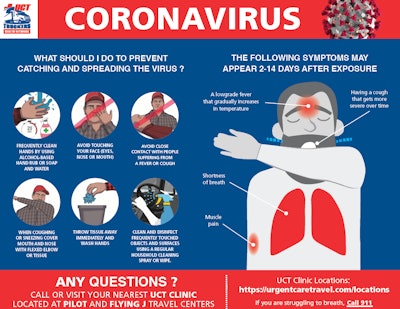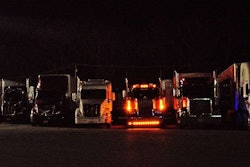Truckers for a Cause medical support group cofounder and long-haul trucker Bob Stanton helped put together the following “decision tree” of sorts in hopes of assisting any driver faced with a decision about just how to proceed if symptoms of the novel contagion present themselves on the road. Consult CDC.gov/Coronavirus for a wealth of resources and the most up-to-date information, as it’s changing rapidly. For related reporting about what fleets employing drivers/leasing owner-ops can do to support their operators through these decisions, read this linked story in Overdrive sister magazine CCJ.
If you …
1) … experience what could be COVID-19 symptoms …
First carefully review the CDC’s symptoms list on its website, linked here; keep in mind mild symptoms are shared by different common ailments, from common colds to influenza.
————
IMPORTANT AT ANY POINT IN SELF-EVALUATION: If you develop any of the following emergency warning signs for COVID-19 complications, as advised by the CDC, get medical attention immediately:
- Difficulty breathing or shortness of breath
- Persistent pain or pressure in the chest
- New confusion or inability to arouse
- Bluish lips or face
In such a case, call 9-1-1 and warn operators you have potential COVID-19 symptoms so first responders can have protective equipment ready.
————
2) … do not have emergency warning signs but still think you might have COVID-19 after reviewing symptoms, best course of action is to call your doctor or get a telemedicine (remote) consult with a medical provider.
A few avenues to telehealth consults, should you need:
 The UrgentCareTravel truck-stop-based clinic network published this infographic detailing basic procedures any individual can take to help prevent possible spread of the COVID-19-causing virus. Click on the image to enlarge, and follow this link to download a pdf version.
The UrgentCareTravel truck-stop-based clinic network published this infographic detailing basic procedures any individual can take to help prevent possible spread of the COVID-19-causing virus. Click on the image to enlarge, and follow this link to download a pdf version.**TelaDoc (Request consult via TelaDoc.com, 800-835-2362, or via Teladoc’s mobile app)

**UrgentCareTravel (Call nearest UCT location, numbers via this link, for its newly launched COVID-specific telemedical service; $40)
**National Association of Independent Truckers (Members have access to the NAIT mobile app’s “24/7 Doctor” telemedicine service for no-cost consultations.)
Find more trucking-specific telemedicine information via this linked 2018 round-up of providers and the following more recent feature:
3) … find that a medical expert agrees you may have COVID-19 and advises a test, it’s decision time:
Head home? | If you’re close enough to get home, do so and get tested, and not just for the obvious reasons. You’ll need to stay wherever you’re tested for days to wait for the results of the test. If the test is positive, you will be there at least seven days (including at least three days with no fever without use of fever reducers, according to CDC guidelines for home care) or until you have two negative COVID-19 tests.
Consider before making this decision, at once: Are there loved ones at home with health conditions that would make them extremely susceptible to COVID? For example, being on chemotherapy or having chronic respiratory conditions like COPD or others discussed on the CDC website. Visit this page on the CDC’s Coronavirus hub page for more information on these considerations.
or…
Get tested on the road? | Use access to a tele-consult to locate an appropriate testing site if you are too remote to safely make it home. Long-term reserved parking is available in a variety of places (via TruckPark.com/locations, for instance); local public health authorities can refer you to appropriate testing locations and protocol. The Urgent Care Travel network is in the process of setting up COVID-19 protection and testing protocols for its network of sites. Their telemedicine operators can connect you to their nearest testing location.
 As of March 22, few COVID-19 testing sites around the nation appeared accessible via tractor-trailer. There are, however, resources on just how to proceed. Consult the Centers for Disease Control for the latest guidance, which changes almost daily: CDC.gov/Coronavirus.
As of March 22, few COVID-19 testing sites around the nation appeared accessible via tractor-trailer. There are, however, resources on just how to proceed. Consult the Centers for Disease Control for the latest guidance, which changes almost daily: CDC.gov/Coronavirus.4) … test positive or are otherwise self-isolating alone or waiting to recover from mild symptoms, set up a welfare check, just in case.
Review CDC recommendations for home care via this link.
A welfare check can be performed by someone you trust to call and check on you. Instruct them to contact local enforcement to make a physical well-being check on your truck if you fail to answer a call. On Facebook, the Truckers for a Cause support group set up the “Truckers Helping Truckers Covid19 Resources and Buddy Watch” group as a resource to potentially help match drivers needing welfare checks with other drivers.
Those tasked with welfare checks should know and review the emergency warning signs at the top of this guide and also know exactly where you are parked. Use the Google Maps app’s location-share function, or share a satellite view screenshot of your location in the parking lot. Make certain a checker knows your truck’s make, model, license plate number and any carrier insignia. Hide a key on the outside of the truck in a place you identify to the welfare checker.
For any self-isolation away from home, stock up on supplies such as you can. Stay hydrated with water and sports drinks. Check on local food delivery options.
If self-isolating in a motel, inform the front desk since there might be concern for room service personnel, and the staff might be able to accommodate special needs.
Likewise, if at a truck stop, talk to management. Some truck stops are setting up an envelope for each self-isolated driver that contains contact information helpful to the driver and allows the driver to provide personal contacts and a key to the truck for emergency access. To be fully prepared for in-cab isolation, consider getting a camping toilet.











